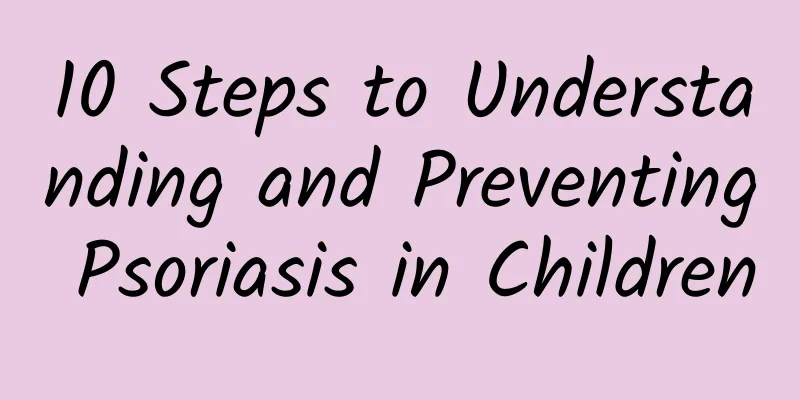10 Steps to Understanding and Preventing Psoriasis in Children

|
What is psoriasis in children? Childhood psoriasis is a skin disease that occurs in children and is related to environmental, genetic, immune and other factors. It manifests as scaly plaques that mainly invade the skin and can also affect the joints, scalp and nails. Pathologically, it is characterized by excessive epidermal proliferation and abnormal keratinization. The location of the disease varies among children, and the average age of disease development is between 7 and 11 years old. What is the prevalence of psoriasis in children? According to the World Health Organization (WHO), psoriasis has an estimated prevalence of 0.70% in children worldwide, with no major differences in gender. Familial susceptibility to psoriasis: If both parents have psoriasis, the child's risk of developing psoriasis is greater than 40%. What are the causes of psoriasis in children? The exact cause of psoriasis is still unclear. It mainly starts with T lymphocyte lesions. These white blood cells originally help protect the human body from infection and disease, but in psoriasis they are overactivated and can also cause other immune responses. At the same time, pharyngitis, stress, and genetic factors are the main causes of the disease in children. What are the symptoms of psoriasis in children? Normally, skin cells start growing from the deepest layer and slowly rise to the surface, constantly replacing dead skin cells, a process called "cell turnover" that takes about a month. In psoriasis, cell turnover occurs in just a few days, causing new cells to rise too quickly and accumulate on the surface. In most cases, psoriasis causes plaques. These plaques usually appear on the elbows, knees, legs, scalp, face, palms, and soles of the feet, and may cause itching or pain, and they can appear in any other area, such as fingernails, toenails, genitals, etc. The difference between psoriasis in children and psoriasis in adults Unlike adults, plaque psoriasis in children has smaller lesions and thinner scales, with itching being the most common symptom. Guttate psoriasis is more common in children than in adults, and streptococcal infection before the onset is more common than in plaque psoriasis. Nail involvement is not uncommon in children with psoriasis, manifested as pitting, uneven nail plates, nail discoloration, nail longitudinal ridges, nail hypertrophy, nail peeling, etc., among which pitting is the most common. Diaper psoriasis is a special type of childhood psoriasis, common in infants and young children under 2 years old. 17% of children with psoriasis present with diaper psoriasis (13% of disseminated type and 4% of localized type), which can be differentiated from diaper dermatitis by combining clinical manifestations, disease evolution and treatment effects. The impact of psoriasis on patients' lives People with psoriasis may experience significant physical discomfort, psychological distress, and even disability. The itching and pain can interfere with some daily activities, such as walking and sleeping. People may experience insecurity, worry, shame, frustration, anger, low self-esteem, and symptoms of depression. Diagnosis of psoriasis in children Because it can be confused with other skin conditions, it may sometimes be necessary to examine a small sample of skin under a microscope to confirm the diagnosis (biopsy). Once the diagnosis is confirmed, the doctor will instruct the patient on how to proceed with treatment. Treatments for psoriasis in children Doctors usually base treatment on the severity of the disease, the size of the affected area, the type of psoriasis, where the lesions are located, and the person's response to initial treatment. Medicines applied directly to the skin (topical treatments), such as corticosteroids. Phototherapy: Treatment based on natural sunlight or narrow-spectrum ultraviolet light. The most widely used oral or injectable medication is methotrexate, while acitretin, cyclosporine, and biological agents have also been reported to be used for childhood psoriasis. Health education on psoriasis in children Studies have confirmed that heredity is one of the determining factors for the onset of psoriasis, the environment plays an important role in the occurrence and development of psoriasis, and mental and psychological stress can also lead to aggravation of the disease. Therefore, in the early stages of the disease, in addition to formulating a reasonable treatment plan based on clinical manifestations and age, health education should also be strengthened for parents and caregivers of children with the disease. How to prevent psoriasis in children? First of all, provide reasonable and adequate nutrition: parents should supplement the patient with sufficient protein, but if the child is allergic to fish, shrimp, crab or other seafood, they should avoid eating them. At the same time, they should reduce the consumption of red meat and high-fat diet, eat more coarse grains, less refined grains, and eat more fresh fruits and vegetables. For individual patients with vitamin D deficiency, oral vitamin D supplements can be recommended, and children are encouraged to eat foods rich in vitamin D such as fish, eggs, dairy products, nuts, etc., and ensure sufficient sunlight exposure. It should be noted that children are in a period of growth, and nutrition is most likely to be deficient at this time, so parents should reasonably supplement their children with nutrients according to the doctor's guidance. At the same time, children with psoriasis are encouraged to perform regular skin care, widely use moisturizers containing different urea concentrations, exercise appropriately, and receive psychological counseling to ensure the physical and mental health of the children, which is also listed as an important part of psoriasis treatment. (Yang Meng, Nanning Second People's Hospital) |
<<: This kind of food is recommended by the whole network in summer, but I advise you not to eat it
>>: Social Anxiety Disorder: The Invisible Symptom of Psoriasis
Recommend
After a woman drinks goat milk for a long time
Many people like to drink milk and think that mil...
What are the early symptoms of cervical cancer?
Presumably, more and more women have paid more at...
What is BB cream? Characteristics of BB cream
BB cream is mainly used to cover blemishes, adjus...
Why does my chest still hurt after an abortion?
After pregnancy, a woman's body will undergo ...
What to do if a woman has inflammation in her private parts
Inflammation of the female private parts is a com...
What factors are associated with systemic lupus erythematosus? What are the diagnostic criteria?
Author: Wu Donghai, Chief Physician of China-Japa...
Do you know? Open the door┋Beware! These dietary misconceptions are not credible, cancer patients should pay attention!
Liu Jiang, chief physician, national health scien...
Is it good for women to drink Da Hong Pao tea?
Jin Jun Mei is a kind of famous tea in my country...
Can a person with depression get pregnant?
Depression is a mental illness with a relatively ...
Can I take anti-gynecitis capsules during menstruation?
Anti-gynecitis capsules are capsules with dark br...
The advantages and disadvantages of genital moxibustion
Gynecological diseases have always been a major p...
How to treat genital redness and swelling?
When female friends find that their vulva is red ...
Identify gynecological diseases by looking at the color of leucorrhea. Three major gynecological diseases that need to be treated before pregnancy
Although female leucorrhea is a normal secretion,...
Can pregnant women eat ice cream occasionally?
Because pregnant women have double bodies, they n...
Are pregnant women more likely to be infected with Toxoplasma?
Pregnant women are more likely to be infected wit...









